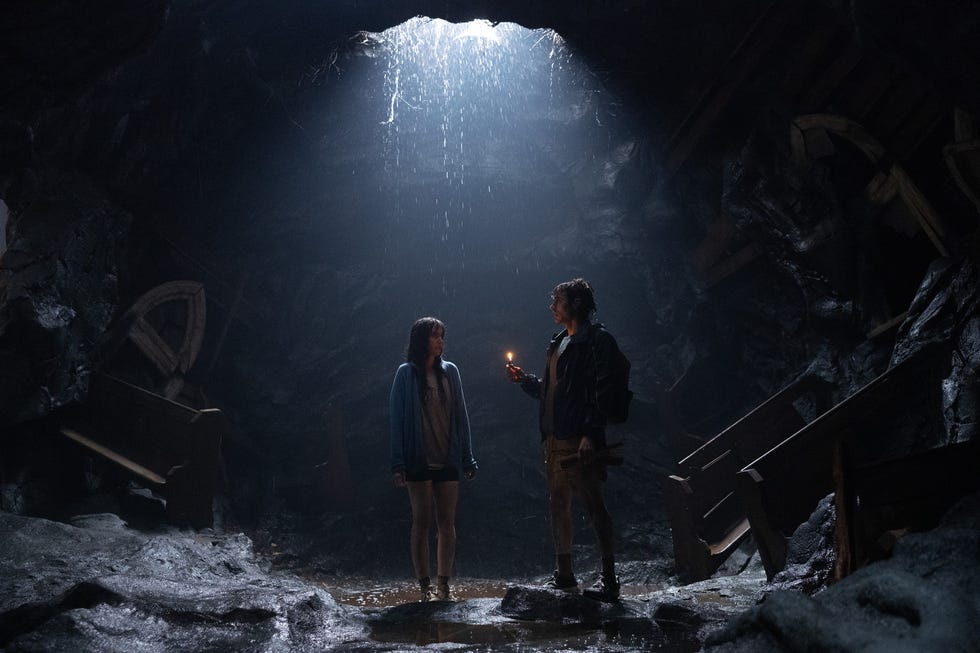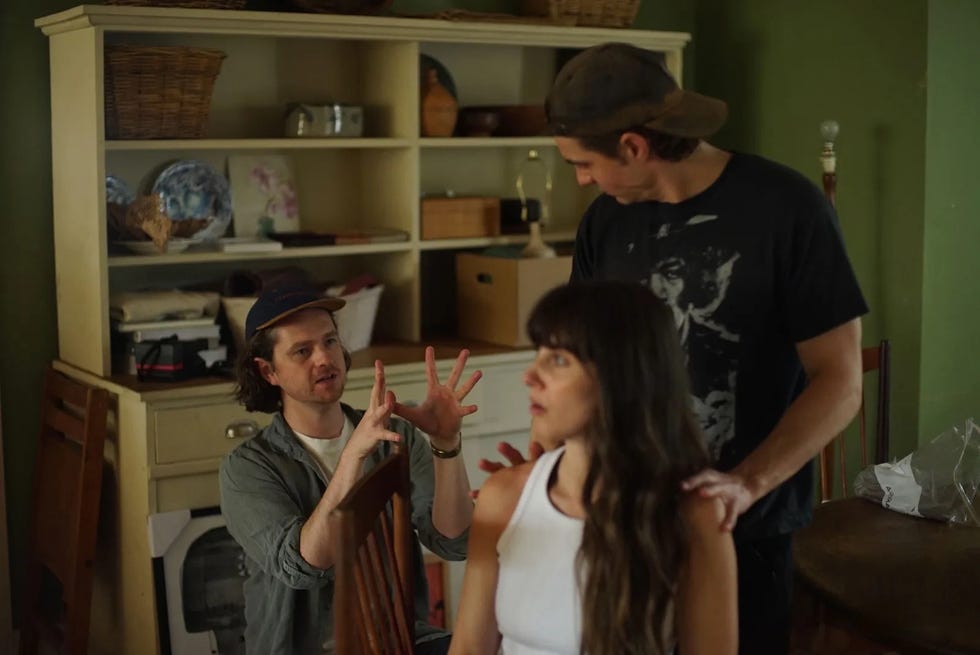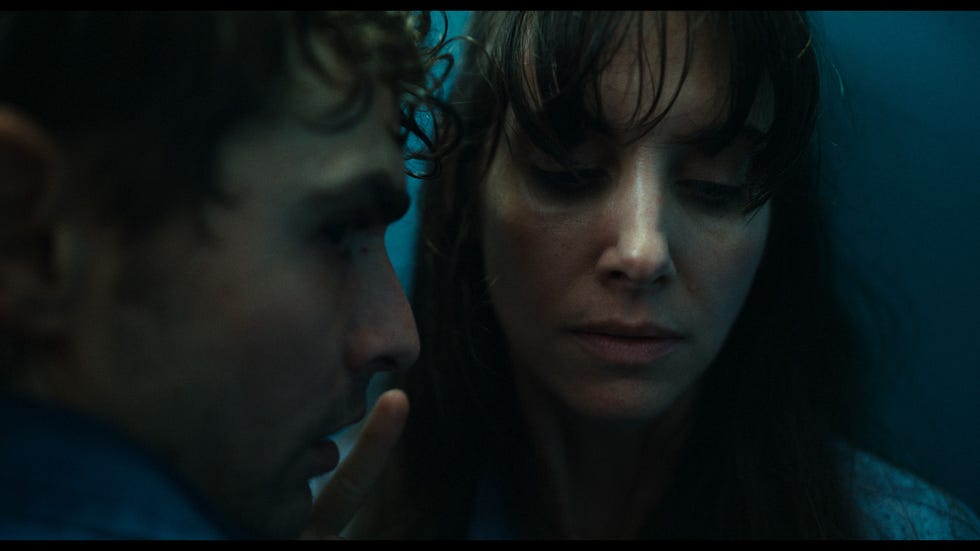<i>Together</i> Made Alison Brie and Dave Franco ‘More Codependent Than Ever’


When co-leads and producers Alison Brie and Dave Franco signed on for Together, Michael Shanks’s wickedly fun body-horror flick about codependency in relationships, an immediate thought crossed the real-life couple’s minds: “This is either going to end in divorce, or we will be more codependent than ever,” Franco says. Joining ELLE on Zoom before the film’s theatrical release, the duo—who’ve been together for over 13 years and married since 2017—look back at that moment with a laugh and a sigh of relief. “Luckily, it was the latter.”
Following Millie and Tim (played by Brie and Franco), a long-time couple who moves from the city to the country to pursue a new life and perhaps marriage, Together is about the myriad ways (sometimes, destructive ones) partners come to excessively rely on each other. In navigating these tricky avenues, filmmaker Shanks smartly employs the body-horror genre, especially when Tim, a struggling musician who still hasn’t had his big break, and Millie, a dependable schoolteacher, sail through some treacherous waters. Ever feel like you’re stuck with your significant other for the good and the bad? Well, let’s just say that Together visualizes that visceral, sometimes frightening idea ingeniously.

Real-life spouses, co-stars, and producers Alison Brie and Dave Franco say they couldn’t have made Together “with anyone else.”
You’d think it’d be at least a little intimidating for an actual couple to dissect a story of such brutal honesty. But not for Brie and Franco. “I don’t think we would have even been interested in being in this film if we didn’t feel like we had a strong, healthy relationship,” Brie explains. Mostly, the horror-loving duo (who’ve worked on The Rental, Horse Girl, and more) was excited to dive into something that felt unique and risky, a creatively satisfying experience that aligned with their taste in film. In the end, Together was educational, too. “It made us evaluate our own codependency, which I think is generally pretty high, but [also], healthy,” Franco remarks. “We still really value our alone time. And hard as it is to be away from each other for long periods [when we’re on separate projects], it’s actually good to get to a point where you miss each other and are excited to reunite again.”
From the start, the couple was well aware that their bond was an advantage when it came to portraying the intricacies and intimacy of Tim and Millie, who have also been a pair for over a decade. On one hand, the easy chemistry Brie and Franco bring to the screen is undeniable. And on a more practical end, the emotionally and physically demanding roles felt safer to tackle together. “We know each other so well, and that made our performances inherently truthful,” says Brie. “We can’t bullshit each other, you know? And at the same time, we trust each other. So implicitly, it made the set a really safe space for us to take big swings in our performances.” Especially within the tight production schedule (the movie was shot over 21 days), that trust was an asset to the actors. “There was no chance for us to overthink things,” continues Brie. “We could just seep into the movie, and it was really satisfying leaving it all on screen. We could go home at the end of every day feeling like we couldn’t have done anything more.”
The two also supported each other when it came to using extreme practical effects. For a particular scene, they spent an entire day physically attached to each other via prosthetics, an experience that made them go, “We couldn’t have done this movie with anyone else.” Franco recalls, “We literally could not leave each other’s side all day, including visits to the bathroom. We would have to drag each other there.” That level of physicality was surely taxing, especially when it came with a side of injuries. “From the very first take early in the morning, our energy had to be at 100 and it had to stay there,” Franco says. “And we actually documented all of my injuries throughout the filming process. So we have a nice collage that we will maybe frame one day.” Franco especially recalls a shower scene that comes earlier in the film, when Tim undergoes a seizure-like attack. “I’m fully nude, my character is unconscious, and I am fully throwing myself against porcelain walls and not bracing myself in any way,” he laughs. “That really hurt.” But on the whole, their excitement and passion for the project superseded the pain—and so, the duo ended up using minimal stunt doubles.

Brie and Franco’s deep, real-life connection also paid off during countless wordless exchanges. They brought their understanding of each other to moments of emotional heft, with no dialogue needed. “There are scenes where our characters are at odds, but you can still feel the love underneath it all,” Franco explains. “And that’s something that comes from being with someone 13 and a half years.” Brie says, “The love underneath was our main focus. You want the audience to be rooting for them to overcome their issues. And you can’t do that without trusting that there is a base level of love and respect between them.”
Though it all, first-time feature director Shanks was the ideal leader and partner, collaborating with Brie and Franco from pre- to post-production. With a background in effects, he did about 150 of the VFX shots himself, and at times, the couple used their established sway as stars and producers to advocate for his creative vision. “We united with him to protect the authenticity of the movie. And we became this beautiful trio,” Brie remarks. “Michael Shanks is the most confident first-time director ever,” Franco adds. “He brings such a joyous, almost kid-like energy to set, and that’s infectious.” That kind of enthusiasm was all over Shanks’s directing style, with frequent references to the genre movies that inspired Together. Brie says, “Michael is an avid lover of horror films, and his encyclopedic knowledge of them was really fun, too. He would [refer to] X-Men 2 for a specific scene. And The Village [for another scene]. And Japanese horror films.” Franco adds, “And [they were] just for single moments. That specificity enhances the whole movie.”

Michael Shanks (left) directs Brie and Franco behind the scenes of Together.
The duo also held onto their own share of horror references throughout production. For Franco, one was Alien, whose visual influence on Together is apparent during a scene that’s set in a cave. (Franco excitedly notes that Together production designer Nicholas Dare had worked on Alien: Covenant.) He also thought of David Cronenberg’s The Fly, his favorite body-horror in cinema. For Brie, a big reference point was The Shining, one of her all-time favorites that she re-watched during pre-production with an eye towards Shelley Duvall. “She is so beautifully vulnerable in it. And there is no vanity in that performance. She is almost cloying in way that feels so real,” Brie explains. “I was hoping to channel that level of lack of vanity. When a person finds themself in such an extreme and scary situation, they’re not going to react in the perfect, most glamorous actor way. It’s going to be human and messy.”
From Don’t Look Now to Midsommar, why do longtime lovers and clingy couples lend themselves so well to horror? Well, these co-stars have theories. “It’s really relatable fears that these movies are playing on,” Brie says. “Everybody has a different relationship to relationships, whether it’s with lovers, or even friends or family. How much do you want to let someone in [and] lose yourself in that equation? The topic is evergreen and the possibilities are endless within the genre.” According to Franco, we all have relationships like these in our lives—and not just romantic ones—whether we’d like to admit it or not. “The concepts that Michael Shanks created for this film have the potential to reach a wider audience [because of that],” he remarks.

Brie thinks horror films can explore “really relatable fears” in relationships.
So, is Together the perfect date-night movie that cheers for completing one another, or is it the greatest advertisement to stay single forever? “We don’t necessarily say that codependency is good or bad,” Franco reflects. “We have had friends of ours who are single, who reached out to us after seeing the film and said, ‘I am so happy I am single,’” he laughs. “And on the flip side, we heard from a couple who was actually in a fight all week leading up to the screening of the film, and then they watched the film and said it actually helped them solve their issues.” Brie concurs that the message will be in the eye of the beholder. “This movie is an examination of fears of monogamy and codependency, and the horror set pieces fuel these themes. Truly, it will reflect back to people their own opinions about relationships.”
elle

%3Aformat(jpg)%3Aquality(99)%3Awatermark(f.elconfidencial.com%2Ffile%2Fbae%2Feea%2Ffde%2Fbaeeeafde1b3229287b0c008f7602058.png%2C0%2C275%2C1)%2Ff.elconfidencial.com%2Foriginal%2F9a3%2Ff96%2F84e%2F9a3f9684eb94d47515f00bf3ebfe0a18.jpg&w=1280&q=100)
%3Aformat(jpg)%3Aquality(99)%3Awatermark(f.elconfidencial.com%2Ffile%2Fbae%2Feea%2Ffde%2Fbaeeeafde1b3229287b0c008f7602058.png%2C0%2C275%2C1)%2Ff.elconfidencial.com%2Foriginal%2Fa97%2F2fb%2Fef5%2Fa972fbef5978400c180465805310bfc5.jpg&w=1280&q=100)


